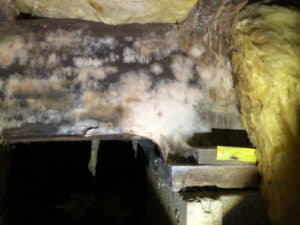How dangerous is mold in your home? The impact on your family and home.

How dangerous is mold in your home? The impact on your family and home.
We all know what mold looks like- it’s the fuzzy growth on food not eaten in a timely fashion or the dark grime that creeps on the grout in the corners of the shower. And sure, you’re conscientious about throwing out spoiled food, and you clean your bathroom regularly. But what about the mold growing where you don’t see it?
Your basement or crawl space might be out of sight, but it should not be out of your mind. Studies have shown that when you are on the main floor of your home, between 40- 50% of the air you breathe is coming directly from your crawl space or basement.
Acculevel has been repairing foundations, basements, and crawl spaces since 1996, and we are an Anabec-trained contractor. Anabec is a manufacturer of premium cleaning chemicals that are designed to remediate and prevent mold with the smallest environmental impact.
In this article, we’ll review the various types of health risks that come from mold inhalation and the consequences for your family and home.
How does mold grow in a house?
Mold spores can be anywhere; you let them in when you open a door or window. You track them in after walking through the grass, or fallen leaves. Children bring them home from school on their clothes or backpack. Once in your home, they collect on any spot that is habitable.
Mold only needs a welcoming environment to grow- and that is easily produced by your basement or crawl space. All it needs is humidity at 70% or higher, a source of food (dust), and darkness. If your crawl space or basement is damp, it is extremely likely that you have mold developing in your house. Breathing in the spores that are released as mold grows can have a variety of negative consequences.
What are the side effects of mold in my house?
When it’s in an area you don’t access on a regular basis, you may not notice any mold growth until you’re smelling a stale, musty odor. And by then? You could already be suffering from the side effects. As soon as you detect that tell-tale odor, please investigate or call a professional for the sake of your and your family’s health.
Breathing in mold spores can cause a wide range of symptoms. According to the National Institute of Environmental Health Sciences, these are the most common ones:
- Nasal and sinus congestion
- Eye irritation
- Blurred vision
- Sore throat
- Chronic cough
- Skin rash
The National Capital Poison Center also reminds us that damp spaces with mold are also likely to have other nasty contaminants. These include by-products that occur as part of mold’s growing process.
As mold breaks down the surfaces in your home, it may be releasing dust mites, bacteria, chemicals, gasses, and particulate matter. Dust mites and chemical odors can be similarly irritating to your sinuses, adding to the congestion or allergic reactions you already have.
Mold growth and wood decay are clearly visible on the beam. This picture was taken by an Acculevel project manager during a routine free estimate.
This picture was taken by an Acculevel project manager during a routine free estimate.
Being healthy doesn’t make you immune
Even if you are a healthy adult, you still need to be concerned about mold-related illnesses. The National Institute of Occupational Safety and Health performed a study on employees working in a water-damaged office building. The results documented a correlation between developing asthma and the increasing mold levels in the building.
You may have few (if any!) allergies, but long-term exposure can change that. And anyone with asthma will tell you, it is not an illness you want to acquire.
For families with infants and children, the impact of mold spores is more significant. Studies have shown that mold in the household contributed to a number of respiratory disorders in children ages 6-12.
These ranged from allergic symptoms and hay fever to wheezing, coughing, and asthma. Mold exposure during the first year of a child’s life can increase their risk of developing asthma.
If you have asthma, or other chronic illnesses
If a member of the household has allergies before exposure, they are at risk of developing asthma. So for family members who already have asthma? Breathing in mold spores can trigger an asthma flare-up, or worsen existing asthma.
For asthmatics or people with a compromised immune system, the effects of mold can be severe. Those at risk can also develop allergic bronchopulmonary aspergillosis. This is a lung infection caused by breathing in spores; it causes fever, fatigue, and chest pain.
People with weakened or compromised immune systems can suffer long-term consequences of mold exposure. A study done by the National Institute of Health noted that people with chronic fatigue syndrome had mycotoxins in their system, even years after the exposure to mold. (Mycotoxins are compounds that are naturally produced by certain types of molds.)
Consequences of mold for your home itself
Clearly, mold presents a danger to the health of you and your family. But it can also damage the structure of your home. Every component of the structural wood framing in your home (beams, joists, sill plate, etc) are all susceptible to mold spores. Left unchecked, there are varieties of mold that will cause the wood to rot and decay. This compromises the structural integrity of your home, and will negatively impact your home’s worth and resale value.
Treating mold in your home will not solve the problem if you have a wet basement or crawl space. As long as it remains sufficiently damp, the mold will return. Long-term exposure to humidity can also damage your home. For more information about waterproofing and why it’s essential, we have two resources. Please check out our guide to basement waterproofing or this blog post that reviews the damage water can do to a crawlspace.
What Should You Do if You Have Mold in Your Basement or Crawl Space?
Find an experienced local foundation company, and make an appointment. Before you sign a contract for any service, you should always verify the company is reputable, insured, and accredited by the Better Business Bureau.
For an overview of the mold removal/repair methods, we have an article that reviews both methods and costs for treatment.
If you live in Indiana or the surrounding states, contact Acculevel. Established in 1996, we specialize in foundation repairs. If you have noticed any signs of mold in your home, you can request a free estimate. An experienced project manager will evaluate your home and recommend the best course of action for you, to keep your home strong and healthy for years to come.
We have also created a free tool that any homeowner can use to see what could be causing problems in your home and how to fix it. Identify problems, explore solutions, and get advice on how and when to take action with our Symptom Checker.
